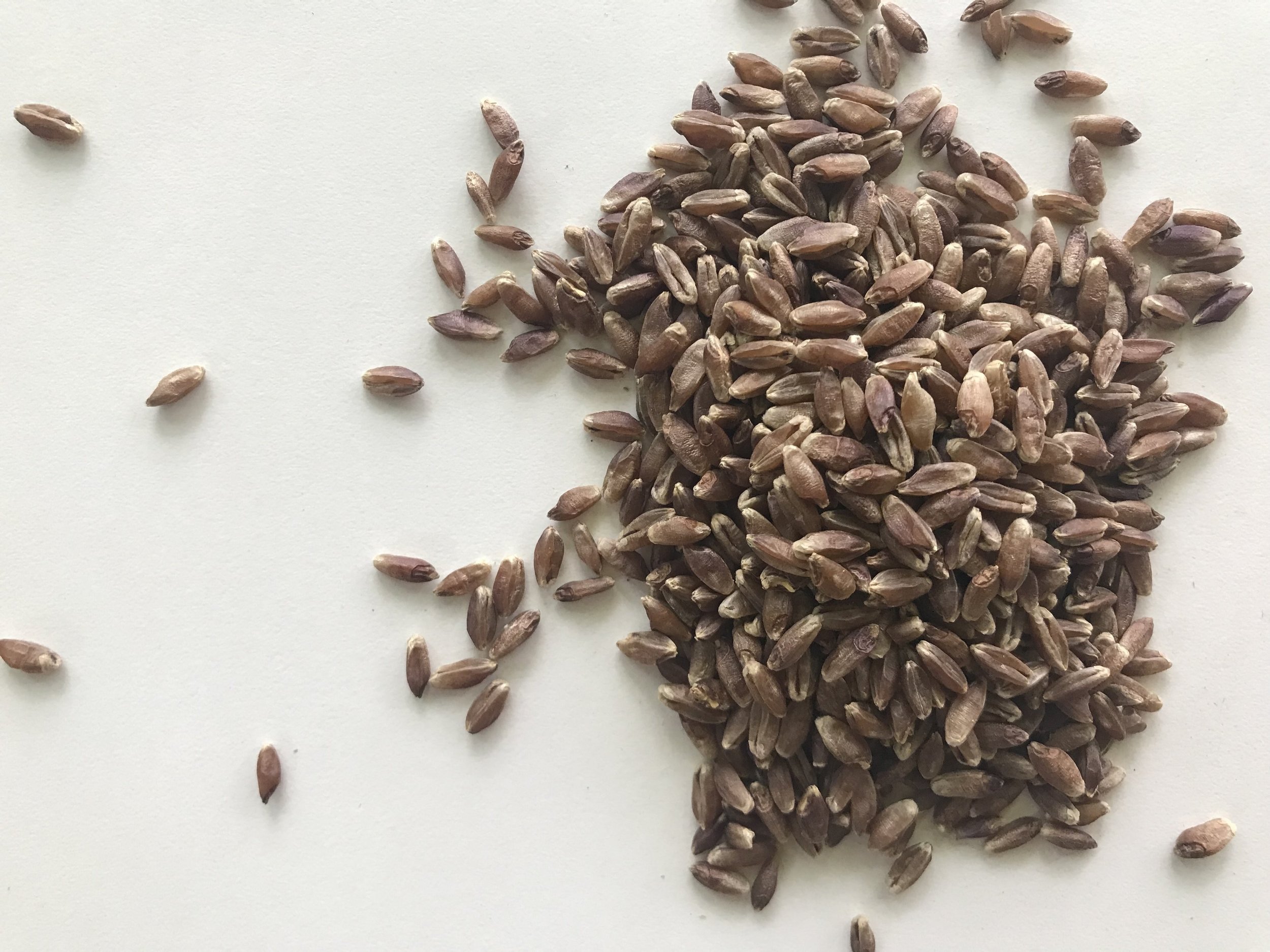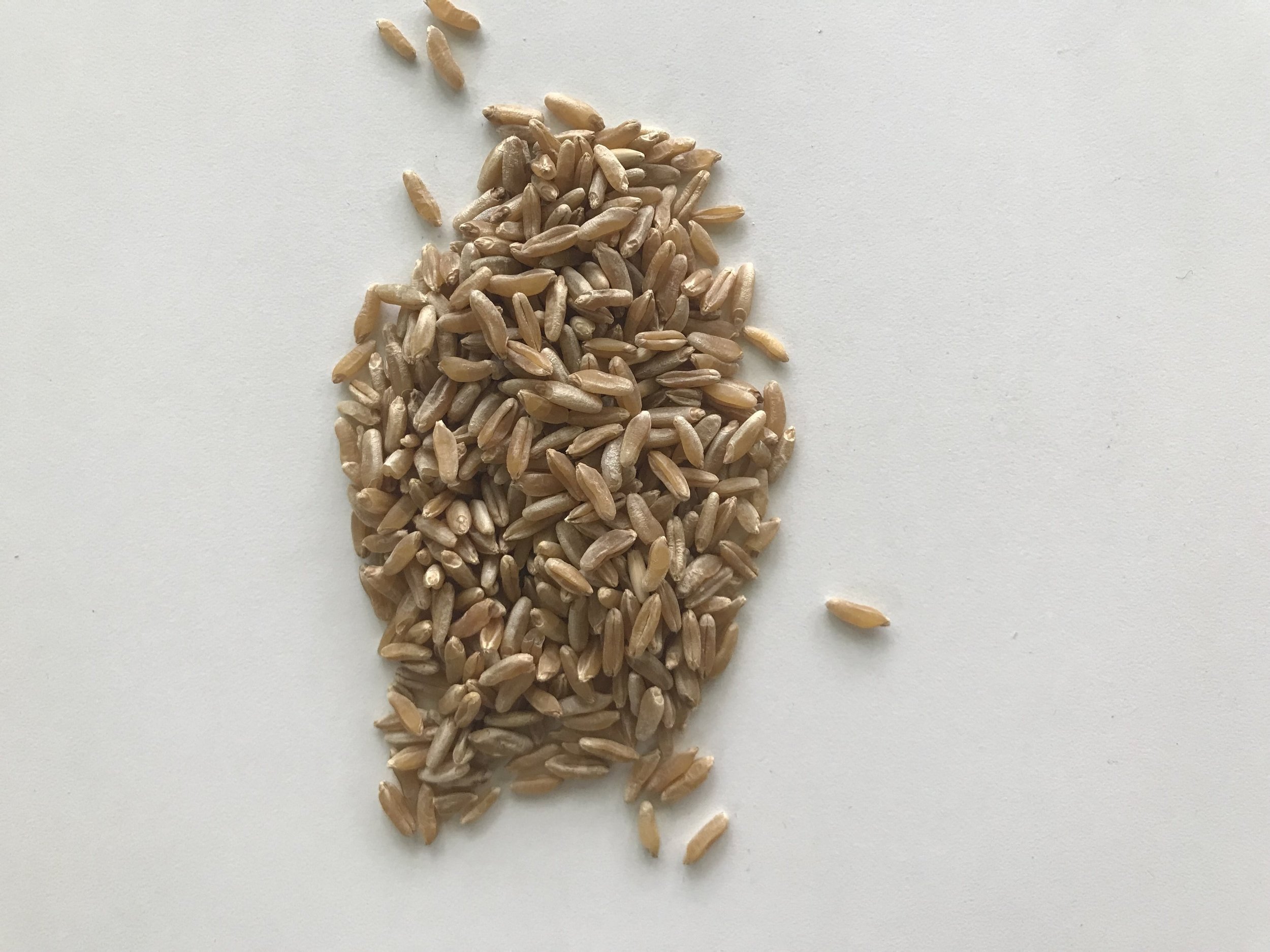Varietals
EINKORN
One of the oldest known cultivated varieties of wheat, it is thought to be the ancestor or Mother of all subsequent strains. Known in Italy as “farro piccolo", it is high in protein but low in gluten quality which can make it behave a bit more quirky in breads. It has an incredible depth of flavor. My friend and master miller Nan Kohler, of Grist & Toll, first unlocked these flavors for me with a blind tasting of shortbread cookies- the simplicity (and the butter!) really showcased this varietal. I suggest trying it for yourself!
EMMER
Commonly known as “farro medio” in Italy and what we know as farro on most restaurant menus, emmer is considered an ancient grain and was domesticated in the Fertile Crescent and cultivated throughout the Middle East and Old Europe.
Emmer is high in protein but has low dough extensibility, making it less successful as a stand alone bread flour. It is the ancestor of durum wheat which makes it an excellent choice for pasta and flatbreads. Its flavor profile is nutty, sweet and grassy. It is delicious cooked as a whole grain.
ETHIOPIAN BLUE TINGE EMMER
Two decades ago Dan Jason of Salt Spring Seeds in BC brought back two seed heads of a variety of emmer wheat from an agricultural visit to Ethiopia and began multiplying it out and sending it to other growers. It has a beautiful bluish hue to the berries and seedheads. The grain has very high protein content but does not generally develop much useable gluten to make it a good stand alone bread flour. It is wonderfully flavorful cooked as a whole grain. I love it in waffles!
SPELT
Another one of the ancient grains, spelt or “farro grande” is the result of a natural hybridization of varieties with emmer as one of its parents. It has a high gluten content and works well as a bread flour with good strength, extreme extensibility and tender open crumb. Also great for, pasta, pastries and all purpose baking. It has a sweet, nutty, well-rounded flavor.
KHORASAN WHEAT or KAMUT
Most likely originating in Mesopotamia, legends exist of this ancient grain being found in Egyptian tombs. However, there is no archeological evidence to support this. Farmers in Turkey call the grain “Camel’s Tooth” because of its shape or the “Prophet’s Wheat”, referring to another legend that Noah brought the grain with him on the ark. It is thought to be the ancestor of durum wheat. Khorasan refers to a historical region in modern-day Afghanistan and the northeast of Iran. This grain is twice the size of modern-day wheat.
Prized for its nutrition, ease of digestibility, sweet, nutty-buttery taste and firm texture, Khorasan wheat adds a beautiful golden color to every recipe. Compared to most modern wheat it has more protein, amino acids, vitamins and many minerals, especially selenium, zinc and magnesium.
I love it in bread, pasta, cakes- pretty much everything!
TURKEY RED
This particular varietal can be traced to Crimea between the Black Sea and the Sea of Azov in the early 19th century and earlier to Turkey to the south of the Black Sea. Mennonite immigrants brought it to the United States in the early 1870s, introducing it to the areas surrounding Marian, Reno and Harvey Counties in Kansas. It became the dominant hard red winter wheat in Kansas and much of the Great Plains bread basket and was the major hard winter variety in the 1920s. Significant acreage was planted in Kansas until the mid-1940s when it was replaced with modern higher-yielding cultivars.
Turkey Red wheat is a hard red winter heritage varietal. It has a unique, rich and complex flavor and excellent baking qualities as well as good protein quality and content. It is a Slow Food USA Ark of Taste variety.
RED FIFE
According to the Canadian Encyclopedia: “Red Fife is Canada’s oldest wheat. One legend states that a load of wheat grown in Ukraine was on a ship in the Glasgow harbour. A friend of Farmer Fife dropped his hat into the red-coloured wheat, collecting a few seeds in the hatband, which he then shipped off to Farmer Fife. The wheat grew. The family cow managed to eat all the wheat heads except for one, which Mrs. Fife salvaged. This was the beginning of Red Fife wheat in Canada.”
Red Fife is a hard red spring heritage wheat varietal. However, its kernels are not always red in color. The Red Fife seed adapted to a great diversity of growing conditions across Canada and became the baking and milling industry standard for forty years, from the 1860s to the turn of the twentieth century. So much so that it is credited as the predecessor to many modern wheats. In baking, it produces 100% whole grain bread with profoundly herbaceous and nutty fresh wheat flavors, a moist, satisfying crumb, and a lovely crust with deep, toasty caramel notes. As a whole grain bread flour, Red Fife is unparalleled.
For most of the twentieth century, Red Fife was grown in very small quantities in plant breeders’ seed collections. Interest in growing heritage wheat started with Sharon Rempel in the mid - 1980s, when she planted a "Living Museum of Wheat" at a living history site in Keremeos B.C. Canada. She was given a pound of plant breeder seed of the varietals Red Fife, Ladoga, Bishop, Preston, Hard Red Calcutta, Marquis and Stanley. She bulked up seed and shared it with others. The seeds and wheat field, heritage gardens and landscapes can be considered 'living artifacts'.
Red Fife was nominated to the Slow Food Ark of Taste in 2003 by Mara Jernigan and Sinclair Phillip of Slow Food Canada. This was the first heritage wheat placed on the Ark.
Red Fife also attracts a certain amount of attention because it is said to possess a lower gluten content than most modern varieties of wheat. Its flavor profile is nutty and sweet.
White Sonora
White Sonora wheat is one of the oldest surviving wheat varieties anywhere in North America. Predating Red Fife and Turkish Red wheat, White Sonora is a soft, round-grained heritage winter wheat with pale red grains that grow on beardless heads - beards or awns are the little spikes you can see on the seed heads.
The earliest records document its existence in the mountain plains of Sonora, Mexico in early 1700 but the wheat surely predates that era by generations. It was widely planted in California by the early 1800s. Up through the Civil War, this wheat variety provided most West Coast residents with their flour and during the war it nourished nearly all troops, on both sides, west of the Mississippi.
When milled to whole grain flour it produces light-colored tortillas and breads, cakes and pastry crusts with a lovely texture and a light and buttery flavor. It is excellent for hand made pastas. I love to blend it with other wheats for sourdough bread and pizza. As a whole grain its berries are plump when cooked with a firm texture.







